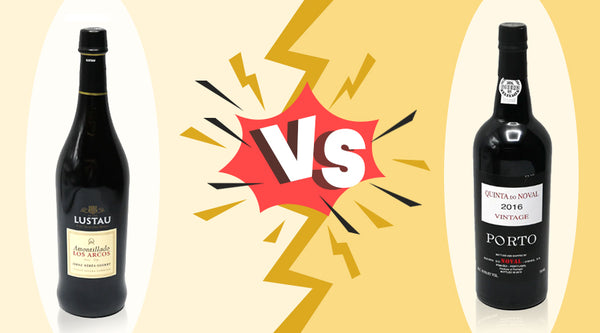Sweet Wines versus Dry Wines: What’s the Difference?

What’s sweet and what’s not? In wine, this can be a matter of personal taste as there are also semi-sweet wines and “dry wines” that still have residual sugar. The driest wine I know is Fino Sherry from Jerez in Andalusia, Spain. It is fermented to total dryness, with no residual sugar.
Sweet wines can be good introductory wines for people who find dryness (and tannins) off-putting when they first start to consume wine. A whole category of relatively sweet, inexpensive white wines exists. The preservation of many a Zinfandel vine in California is owed to the popularity of sweet White Zinfandel!
There are also superbly complex wines with lots of residual sugar, such as the dessert wines like Sauternes and Vin Santo. Port, in all its varieties, is also sweet and truly something for connoisseurs. Any good restaurant wine list should have options for Port, dry Sherry, and dessert wines. Even sweet wines should have all the hallmark characteristics of a great wine. According to Master of Wine Nick Jackson in the second edition of his book Beyond Flavour, these include typicity, balance, length, intensity of flavor, concentration, and ageability. Other incredibly important components for sweet or dry wines include complexity and beauty, says Jackson. You will find many such wines available at your favorite wine stor USA!
The combination of sweetness with aromatics is typical of wines made from Muscat grapes (also called Muscadelle or Moscato). Rieslings and Gewurztraminers can also be sweet and are definitely aromatic, often offering a floral bouquet to the nose. Often people sense that highly aromatic wines are sweet, with lots of residual sugar, though this actually may not be the case.
How Are Sweet Wines Made?
There are two broad categories in terms of making sweet wines. To understand this, you must know that the yeast in grape must (the juice that’s being converted to wine) consume the extant sugars and produce alcohol (and lots of CO2). When the alcohol gets too high, the yeast die, and fermentation stop. So there’s a relationship between natural sugars and alcohol content, up to a point.
One way of making a sweet wine is to intentionally stop fermentation, leaving residual sugar in the wine, and making it sweet or semi-sweet, depending on the winemaker’s goals. Another way is to start with grape must containing extremely high sugar levels, which is often the case for dessert wine. Even though the fermentation is complete, the yeast die when there’s still a lot of sugar remaining in the wine. This can be accomplished in the vineyard through different factors: freezing, for example, which produces sweet ice wines. There’s a fungus that attacks grapes called Botrytis. It causes micro-perforations in the grape skins, which dehydrates them (but not enough to make raisins). The grapes are also left on the vine, producing more sugar. The result is an extremely flavor-laden, sugary must. The resulting wines are termed botrytized.
This is how Sauternes and some other dessert wines end up with both high alcohol levels and lots of sweetness and complex flavor and aromas. Sauterne wine also features balancing acidity complimenting often-concentrated flavors of honey, dried apricots and almonds —a perfect combination of elements! Sauterne wines are often made from Semillon.
Any grape variety can be produced into a sweet or a dry wine, of course. This just depends on continuing fermentation until there is essentially no sugar left for the yeast to eat. Port, which is a sweet red wine, is made in a different way. So are some unusual Spanish wines.
With Port, red wine must is naturally fermented, but at the winemaker’s desired sugar level, grape spirits are added to the must, which raises the alcohol level, killing the yeasts. This result in a high-alcohol (fortified) wine that still has lots of fruit flavor and still high levels of sugar. The resulting wine is also extremely stable because of the high alcohol, which is what the inventors of Port were looking for centuries ago. Port’s cousin from the Iberian Peninsula, Sweet Sherry, is somewhat similar, but still distinct. Here, dry (Fino or Oloroso) and sweet wines are blended. And I am talking about very, very sweet wine. In fact, some wines from Jerez are 100% natural sweet wine made from Pedro Ximenez grapes. They are allowed to dry out in the sun, a process called soleo. In the first place, these grapes are allowed to produce huge amounts of sugar, about 300 grams of sugar per liter of must!
Here are a few sweet wines to consider from wine store USA Bottle Barn, plus a completely dry sherry from a storied producer:
- Lustau Solera los Arcos Dry Amontillado Sherry
- 2020 Fritz Haag Brauenberger Juffer Riesling Kabinett
- 2016 Quinta do Noval Vintage Port
- 2018 Quady Elysium Black Muscat
- 2016 Domaine Huet Vouvray Cuvee Constance
- 2001 Selbach-Oster Zeltinger Himmelreich Riesling Eiswein (that’s ice wine!)
Did you enjoy learning about sweet wine (and dry wine), then please visit our other wine articles! Leave us a comment below too!
By Charlie Leary


















Leave a comment